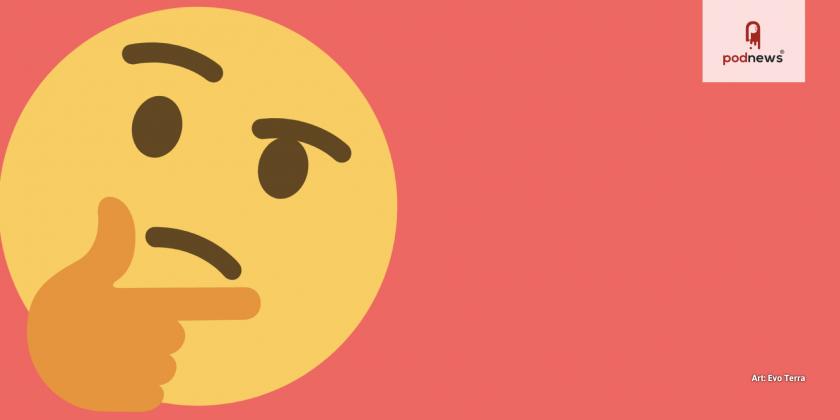
How I make... Podcast Pontifications

This article is at least a year old
- “Where plenty of podcasts about podcasting (PAPs) tell you what to do, Podcast Pontifications what to think about in podcasting.”
People often ask me why it takes me 3.5 hours to produce an episode that lasts for less than 10 minutes. Then they ask me why I do it four times a week and have done so for almost 350 episodes. I shall explain, but let me cover the gear first:
Sound Conditioning: I have seven (7) Audimute fabric acoustic panels mounted on my office/studio/spare bedroom walls. Each is 2’x4’ (61cm by 122 cm for literally everyone else in the world other than Americans), with six on the walls adjacent to my microphone and one on the wall on the far side of the room. Behind me are two isolé® Sound Barrier Sheets blocking the sliding closet doors and effectively eliminating any reflection re-entering my microphone. Yes, that’s a lot. But, with the possible exception of the grey sheets blocking the closet, it looks beautiful in there and very much not like a studio.
Microphone: Shure SM7B mounted on a VIVO swingarm-mount. I use the optional “football” foam windscreen that comes with the mic instead of the thinner standard screen. But it means I don’t have to use a pop filter. That, and I’m good at controlling my plosives.
Audio Interface: Zoom H6, which is underpowered for a gain-hungry mic like the SM7B. While I can boost the gain, running the H6 at 95% gain exposes the relatively noisy electronics inside. So I use a Fethead in-line mic preamp, which is built with wizardry to increase the gain and, weirdly, lowers the noise floor. See “wizardry”. (Nota bene: I have an EVO 8 on order from Audient. Not just because of the name. But OK, mostly because of the name. I won’t need the Fethead with this interface, and the H6 will be pressed into service as a field recorder. If I can ever go out and record in the field again.)
Computer: Mac Mini, which is my dedicated studio computer. Small, noise-free, reliable, and rather affordable, I think.
DAW: Hindenburg Journalist Pro, using Izotope RX-7 Elements, Nectar 3, and Vocal Rider by Waves Audio. Always. Every time.
Camera: No, Podcast Pontifications is not a video podcast. But yes, there is a video version. All recorded on a Logitech C920. Oh, and a cheap-ish ring light to improve my lighting. Remember when I said it’s not a video podcast? Yeah, it’s not. It’ll make more sense in a moment.
Media Hosting Company: Captivate.fm, of which I sit on the Advisory Board. (Disclosure - so does Podnews’s Editor).
Website: PodcastPontifications.com is managed via and hosted by Webfow, a very cool no-code site builder and hosting platform that I’m growing quite fond of, even though I’m no designer.
Other Software: Sharethrough’s Headliner Analyzer, Unsplash, Preview, Descript, Google Docs, Canva, Webcam Settings, Substack, Medium, Buffer, Kid3, and either Wirecast (or Quicktime as a backup).
All right, I think I’ve thoroughly exhausted the list of “things”. Let’s get into why this takes me 21x the length of my episodes to make one, shall we?
Pre-production: This is worthy of a bulleted list, methinks.
-
I usually, though not always, have a good idea of tomorrow’s episode before I turn in for the evening, with both the topic and the angle percolating in my grey matter.
-
The next morning at or before 6:30 am, I begin agonizing over titles using Sharethrough’s Headline Analyzer. I’ve been a copywriter for years, so I usually only go through three or for revisions before settling on one.
-
I find a tangentially-relevant image to represent the image on Unsplash, crediting the photographer, because I am a good digital citizen.
-
The title and the image are used to build the three different image formats (wide, square, and fake audio player) using easily customizable templates on Canva. I resize them (dimensions and weight) with Preview.
-
I open a blank Google Doc, paste in the title, and then make a very brief “script” for the show. I usually (though not always) start by making a few bullet points to keep my rambling brain mostly on track and headed toward the conclusion. Then I script out precisely what I’m going to say -- as in narrate -- for both the cold open and the first sentence uttered after my standard intro.
-
I open Wirecast and change the output settings to send my camera’s signal, my mic’s signal, and both the wide image created in Canva and the raw image from Unsplash to Wirecast and establish a connection to LinkedIn Live. (Unless that’s broken, because LinkedIn. Then I just use Quicktime.)
Production
- It should be just about 7:00a now, at which time I turn on the ring light, launch the presets in Webcam Settings (how I love literal product names), and start streaming to LinkedIn Live. I usually chat with the minimal number of people who like to watch the live process for a few minutes, then hit “Record”, following the script I’ve created. I stop recording before 10 minutes is up but keep the stream running for a few minutes after to chat with anyone who happens to be there still.
Post-Production
-
By 7:20a, the entire raw video recorded by Wirecast or Quicktime goes into Hindenburg Journalist Pro for some quick trimming of the top and tail, the addition of the audio stinger (licensed from Audioblocks and of which I change each season because I can, not that you should), and the application of the various filters and plugins mentioned above. No more than 5 minutes of work, because I am the one-take wonder.
-
The exported .mp3 file then goes to Descript for a full transcription.
-
The transcription is copied and pasted back into the Google Doc that contained the rough script, replacing everything but the title and the subtitle (which is used as the cold open as well as the social shares to come).
The Writing
Because my episodes are only loosely scripted, I often find myself feeling out the topic as I record my thoughts aloud. To me, that’s part of the charm of the audio. I’d even call it “authentic” if I didn’t despise the term.
However, what makes for a compelling listen does not necessarily make for a compelling read, and a surprisingly large percentage of my audience prefers to read my words. That’s fine with me. To facilitate that, take the ~1,500-word transcript and re-write it. Yes. All of it. Oh, I might save a sentence here or there, and I do preserve the overall flow of the content as it will be presented in audio. But I re-write everything, which allows me to engage the editorial parts of my brain to clean up after the live performer. Sometimes I expand on elements only mentioned briefly in audio. Usually, I cut a lot of the repeats and reinforcement that works well in audio but reads quite repeatedly in the text.
When I’m happy with the final text of the article, I create a condensed version used as the episode details. You likely refer to this as “show notes”, another term that I loathe.
It’s now somewhere around 9:00a. 2.5 hours have passed since I sat down at the studio computer.
Publishing & Distribution
I send Allie, my production assistant, the raw video, the wide image, the raw image, and the Google Doc that now contains all the text necessary for publishing the video. No, this isn’t a video podcast. But she’ll post the video to LinkedIn, my company’s Facebook page, and to YouTube. She trims the video and inserts the transitions, much as I did for the audio. This takes her about a half-hour.
Meanwhile, I use the text to finalize the .mp3 file’s ID3 tags (yes, I still use them), schedule the article for publishing on my website, post the audio file on Captivate, schedule the newsletter to publish on Substack, and schedule the social shares via Buffer.
Once I’m satisfied that the text and the audio are correctly scheduled for today’s episode, I syndicate yesterday’s episode to Medium.
It’s now 9:30. The episode goes live at 10. Time for more yerba mate and to start my day.
The end.





























































































